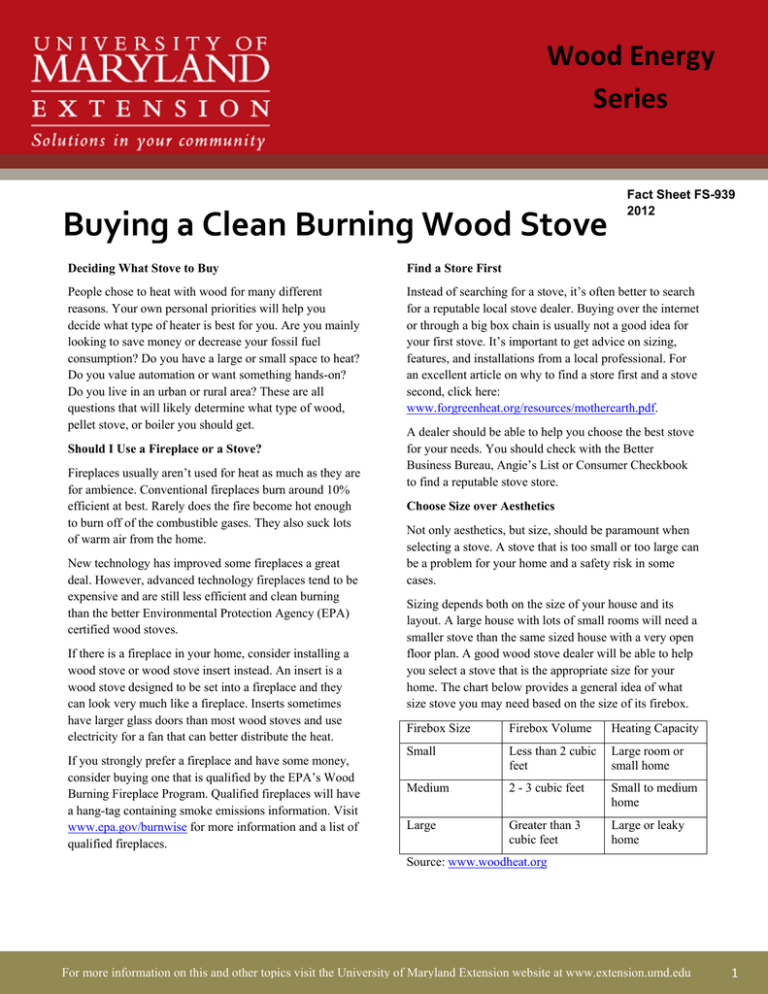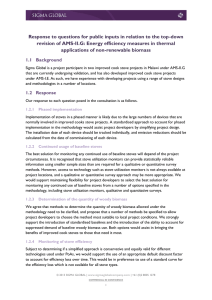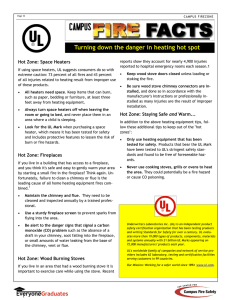Buying a Clean Burning Wood Stove Wood Energy Series
advertisement

Wood Energy Series Buying a Clean Burning Wood Stove Fact Sheet FS-939 2012 Deciding What Stove to Buy Find a Store First People chose to heat with wood for many different reasons. Your own personal priorities will help you decide what type of heater is best for you. Are you mainly looking to save money or decrease your fossil fuel consumption? Do you have a large or small space to heat? Do you value automation or want something hands-on? Do you live in an urban or rural area? These are all questions that will likely determine what type of wood, pellet stove, or boiler you should get. Instead of searching for a stove, it’s often better to search for a reputable local stove dealer. Buying over the internet or through a big box chain is usually not a good idea for your first stove. It’s important to get advice on sizing, features, and installations from a local professional. For an excellent article on why to find a store first and a stove second, click here: www.forgreenheat.org/resources/motherearth.pdf. Should I Use a Fireplace or a Stove? Fireplaces usually aren’t used for heat as much as they are for ambience. Conventional fireplaces burn around 10% efficient at best. Rarely does the fire become hot enough to burn off of the combustible gases. They also suck lots of warm air from the home. New technology has improved some fireplaces a great deal. However, advanced technology fireplaces tend to be expensive and are still less efficient and clean burning than the better Environmental Protection Agency (EPA) certified wood stoves. If there is a fireplace in your home, consider installing a wood stove or wood stove insert instead. An insert is a wood stove designed to be set into a fireplace and they can look very much like a fireplace. Inserts sometimes have larger glass doors than most wood stoves and use electricity for a fan that can better distribute the heat. If you strongly prefer a fireplace and have some money, consider buying one that is qualified by the EPA’s Wood Burning Fireplace Program. Qualified fireplaces will have a hang-tag containing smoke emissions information. Visit www.epa.gov/burnwise for more information and a list of qualified fireplaces. A dealer should be able to help you choose the best stove for your needs. You should check with the Better Business Bureau, Angie’s List or Consumer Checkbook to find a reputable stove store. Choose Size over Aesthetics Not only aesthetics, but size, should be paramount when selecting a stove. A stove that is too small or too large can be a problem for your home and a safety risk in some cases. Sizing depends both on the size of your house and its layout. A large house with lots of small rooms will need a smaller stove than the same sized house with a very open floor plan. A good wood stove dealer will be able to help you select a stove that is the appropriate size for your home. The chart below provides a general idea of what size stove you may need based on the size of its firebox. Firebox Size Firebox Volume Heating Capacity Small Less than 2 cubic feet Large room or small home Medium 2 - 3 cubic feet Small to medium home Large Greater than 3 cubic feet Large or leaky home Source: www.woodheat.org For more information on this and other topics visit the University of Maryland Extension website at www.extension.umd.edu 1 British Thermal Units (Btu) are a measure heat output. One Btu is the energy it takes to raise the temperature of one pound of water one degree. Most stoves heat in the 25,000 to 80,000 Btu range, meaning they can usually heat a home between 1,000 and 3,000 square feet depending on where you live, your house’s layout and how well it’s insulated. It’s very important to buy a stove that is the correct size, not too big or too small. Too big a stove can become a safety hazard if you burn low-heat, smoldering fires. These lead to excessive creosote buildup in the chimney and increase the risk of chimney fires. Too small a stove can lead to over firing and not being able to hold coals overnight. The list of EPA certified stoves may be found here: http://www.epa.gov/burnwise/appliances.html. Stoves that are EPA certified will have a label on the back. If you are still unsure if a secondhand stove is EPA certified, check if it has glass. Stoves with glass are more likely to be EPA certified because tempered glass started to be used in 1988 – the same year the EPA’s certification program began. Should I Buy a Freestanding Stove or an Insert? Freestanding wood stoves and inserts are basically the same thing and work the same way. Both can be installed in an existing fireplace, but unlike a freestanding stove, the insert must be in a fireplace and be able to use electricity to power fans that help improve heat circulation. The primary difference is an aesthetic one, as the insert can look more like a fireplace. Many people prefer to put a freestanding stove in their fireplace and let air naturally circulate around the stove rather than using electricity to push the air out of the enclosed space created by the insert. Freestanding stoves placed in a room instead of a fireplace can emit a significant amount of heat through the pipe, assuming there is at least 3-6 feet of exposed single wall pipe. A stove or insert in a fireplace will have virtually no exposed pipe, but a chimney liner may be necessary depending upon the age and condition of your chimney. Always have the chimney inspected prior to installation. EPA Certification and Emissions It’s important to purchase an EPA-certified wood stove whether new or used because you will get a safer, higher efficiency and less polluting stove. EPA started certifying stoves in 1988 and they are required to emit less than 7.5 grams of particulates per hour, compared to the older, uncertified stoves that emit 20-40 g/hr. Smoke is made up of small particulates of unburned wood that can generate lots of Btus when re-burned. An EPA-certified stove can reduce your wood use by 30% and save you lots of money and time refueling by re-burning the smoke before it leaves your stove. A sampler hang tag that can be found on new EPA certified stoves. Note the measurements for smoke, efficiency and heat output. Unlike the smoke (emissions), the efficiency rating is a very general estimate and cannot be relied on. Catalytic and Non-Catalytic Stoves Among the EPA-certified wood burning stoves made today, there are two basic types: catalytic (cat) and noncatalytic (non-cat) stoves. Cat stoves use catalytic combustors similar to those used in cars to reduce emissions and increase efficiency by burning the combustible gases that would normally escape through the chimney. Cat stoves produce a long, steady, low output burn and are generally cleaner burning than noncats. Balancing these advantages, cat stoves require more attention and need more operator skill, so they are not for those who prefer a hands-off heater. Catalytic stoves have a “bypass damper” that the user must close when the stove reaches a sufficient temperature so that the exhaust can be directed through the catalyst. Both cat and non-cats can degrade overtime. A cat stove must have its catalyst replaced every 4 - 10 years, depending on use and age of the stove. Older model cat For more information on this and other topics visit the University of Maryland Extension website at www.extension.umd.edu 2 stoves gave them a bad name because the catalysts often failed and needed to be replaced every 1 – 2 years. average is about 12-24 hours. The larger the mass of the masonry, the longer the heat output tends to be. Masonry heaters are not yet required to be tested for emissions by the EPA, but most produce low emissions below two grams per hour. Efficiency figures have been reported as high as 80 or 90 percent. Other than cost, the main drawback of masonry heaters is that they can’t heat up a home quickly from a cold start. Pellet Stoves A cross-comparison of a cat and non-cat stove. The cat stove pictured here is an older model that has the catalyst horizontal and directly above the fire. Newer models have them protected from the fire and they are usually vertical. Non-cat stoves are cheaper to buy and easier to operate, but not as efficient as cat stoves. About 85% of stoves sold in the US are non-cat stoves. Non-cats work by injecting pre-heated air into the fire to ignite gases, smoke and creosote. They contain an insulated firebox and use a variety of secondary combustion strategies. The baffle and some internal parts of a non-cat may require replacement from time to time. Most stoves are constructed either out of cast iron or welded steel. Cast iron stoves are often considered the fancier option, but are pricier and may require resealing. Masonry Heaters Masonry heaters, with their small but powerful fireboxes, snaking smoke channels and thick, heat-radiating mass, have provided warmth to the coldest regions of Europe and Asia for centuries and are one of the oldest types of wood burning heaters. More expensive than wood stoves, masonry heaters start at around $7,000 for a basic heater core and small masonry mass. The more expensive ones can cost up to $20,000 with installation. Many masonry heaters can resemble massive fireplaces that dominate a room, but some take up only as much space as a large wood or pellet stove. These woodburning heaters only need to be loaded and fired once or twice a day and use less fuel than wood stoves. Once the wood is burned, a masonry heater can heat a whole home for up to 30 hours at a time, although the Invented in 1973 and introduced onto the U.S. market in the 80s, the pellet stove is considered by some to be the future of wood heat because of its automation, cleanliness and convenience. In urban environments where natural firewood is harder to come by, pellet stoves are often the preferred option over wood stoves. Pelletized fuel is compressed sawdust usually produced by lumber mills and furniture factories. Pellets come in 40-pound bags, which are fed into a hopper on the stove unit or delivered in bulk to a storage bin in the basement. Some pellet stoves are designed to burn corn kernels or even cherry pits. These are known as “multi-fuel” pellet appliances. The Pellet Fuels Institute estimates that about one million American homes are heated with pellet stoves today. Pellet Stove or Wood Stove? Pellet stoves produce fewer emissions than wood stoves thanks to their controlled combustion chamber and low moisture fuel. As a result, they may be better suited for suburban and urban environments where air quality can be more of an issue and inexpensive cordwood is harder to find. With the price of pellets averaging about $263 per ton in 2012 in Maryland, the cost of fuel will be higher than cordwood and similar to natural gas but much lower than oil, propane, and electricity. Installing a pellet stove usually costs less than installing a wood stove because pellet stoves can be vented through the wall, like a clothes dryer. Although they don’t require a chimney, maintenance and repairs are more necessary than with wood stoves. Also note that pellet stove require electricity and will not work in a blackout. Many people find they do not have the natural ambience of a wood stove. Pellet stoves are more convenient than wood stoves thanks to their self-regulating mechanisms that automatically add the perfect amount of fuel and air For more information on this and other topics visit the University of Maryland Extension website at www.extension.umd.edu 3 needed to maintain a desired temperature. They also are easier to keep burning 24 hours a day. Pellet stoves require periodic ash removal and cleaning, so they are not as automatic as a fossil fuel furnace. Pellet stoves tend to cost about $500 more than wood stoves, but the installation can be $500 less, rendering the total cost about the same – usually $2,000 - $3,500. Considerations for Buying Pellet Stoves • If you want your pellet stove to still work in the event of a power outage, buy a model that has a back-up battery pack. • The noise of the blower can be irritating for some, so listen before you buy and research which are quieter. • Pellet stoves require more routine maintenance and annual cleaning than wood stoves, but wood stoves require frequent loading and more ash removal. They also have moving parts that can break down. It is likely that your dealer will be your default service provider, so choose one with a good reputation. • Reviews of pellet stoves may be found on www.wiseheat.com, www.consumerreports.com or http://www.forgreenheat.org/consumer_resources/consum er_resources.html. How to Choose a Wood or Pellet Boiler Installing an indoor or outdoor wood or pellet fired central heating boiler or furnace may make sense if you are looking to heat your entire home that cannot be heated by a stove alone. Wood and pellet boilers and furnaces are widespread in Europe and gaining traction in the U.S. as a replacement for (not a supplement to) fossil fuel furnaces. Pellet boilers and furnaces using bulk pellets offer homeowners virtually the same convenience as a fossil fuel furnace by feeding fuel automatically from a large storage area. combustion chamber at the rate needed to create a pre-set temperature. Should I Buy an Outdoor or Indoor Boiler? Outdoor wood boilers (OWB) burn wood to heat water for nearby buildings. They are located inside their own insulated sheds. The ones that are not qualified by the EPA’s Phase II program are controversial because they often produce heavy smoke through short (6-10 feet tall) smokestacks. Because these boilers are large and located outside, operators are more likely to burn garbage and unsplit and unseasoned wood. Unqualified outdoor wood boilers often produce large amounts of low hanging smoke and have been the source of numerous neighborhood complaints in Maryland. Indoor boilers, on the other hand, usually burn cleaner but there is no EPA program that designates cleaner burning ones. Indoor boilers are typically located in the basement of the home and can provide as much heat as a fossil fuel boiler. They can be very modern, contain advanced emission reduction equipment such as Lambda sensors to regulate combustion, and have thermal storage systems. These modern boilers usually cost $5,000 - $12,000. EPA Phase II vs. Older Outdoor Boilers The EPA created a voluntary program for cleaner outdoor wood boilers that’s in its second phase right now. Boilers that meet the voluntary emissions standards for Phase II (0.32 lb/MMBtu or about 90% cleaner than unqualified boilers) have a permanent label and a hangtag. Twelve states, including Maryland, only permit the installation of Phase II units. Unlike conventional fossil fuel furnaces and boilers, wood furnaces and boilers require owners to re-fuel with cord wood. If a homeowner is willing to put in this maintenance time, these appliances can provide huge savings on home heating bills. Both pellet and wood burning furnaces and boilers must have ash removed periodically, but beyond that, a pellet stove can be as convenient as a conventional furnace or boiler. Like a large-scale pellet stove, the pellet furnace automatically draws fuel from a storage site and feeds it into the For more information on this and other topics visit the University of Maryland Extension website at www.extension.umd.edu 4 Review and Economic Considerations Wood Appliance Typical Efficiency Typical Emissions Typical Cost Conventional Fireplace -10 – 10% 50 grams per hour $1,000 $2,000 Advanced Technology Fireplace 50 - 70% >1 - 5 grams per hour Variable Outdoor Boiler EPA Phase II 45 - 80% 2 - 18 grams per hour $10,000 Indoor Boiler 40 - 90 % >1 - 20 grams/hour $5,000 $20,000 Fireplace Insert, EPA 55 - 75% 1.5 - 4.5 grams per hour $2,000 $3,500 Cat Stove, EPA Certified 70 - 85% 1-4 grams per hour $1,500$4,000 Non-cat Stove, EPA Certified 60 - 75% 1.5-4.5 grams per hour $800 $3,500 Pellet Stove 60 - 75% 1-2 grams per hour $1,500 $4,000 Masonry Heater 75 - 90% >2 grams per hour $7,000$20,000 Certified How to Buy the Right Stove by Wood Heat Organization http://www.woodheat.org/buy-right-stove.html Pellet and Wood Stove Buying Guide by Consumer Reports http://www.consumerreports.org/cro/pellet-and-woodstoves/buying-guide.htm Additional Resources The Best Clean Stoves by Alliance for Green Heat: http://www.forgreenheat.org/consumer_resources/clean.ht ml EPA List of Certified Wood Stoves http://www.epa.gov/Compliance/resources/publications/m onitoring/caa/woodstoves/certifiedwood.pdf This publication, Factsheet FS-939, is a series of publications of the University of Maryland Extension and Forest Stewardship Education Program (www.naturalresources.umd.edu) in cooperation with the Alliance for Green Heat (www.forgreenheat.org). The information presented has met UME peer review standards, including internal and external technical review. Issued in furtherance of Cooperative Extension work, acts of May 8 and June 30, 1914, in cooperation with the U.S. Department of Agriculture, University of Maryland, College Park, and local governments. Cheng-i Wei, Director of University of Maryland Extension. The University of Maryland is equal opportunity. The University’s policies, programs, and activities are in conformance with pertinent Federal and State laws and regulations on nondiscrimination regarding race, color, religion, age, national origin, gender, sexual orientation, marital or parental status, or disability. Inquiries regarding compliance with Title VI of the Civil Rights Act of 1964, as amended; Title IX of the Educational Amendments; Section 504 of the Rehabilitation Act of 1973; and the Americans With Disabilities Act of 1990; or related legal requirements should be directed to the Director of Human Resources Management, Office of the Dean, College of Agriculture and Natural Resources, Symons Hall, College Park, MD 20742. For more information on this and other topics visit the University of Maryland Extension website at www.extension.umd.edu 5




